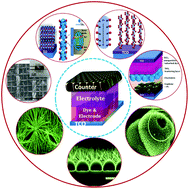Our official English website, www.x-mol.net, welcomes your feedback! (Note: you will need to create a separate account there.)
Nanoarchitectures in dye-sensitized solar cells: metal oxides, oxide perovskites and carbon-based materials
Nanoscale ( IF 6.7 ) Pub Date : 2018-02-12 00:00:00 , DOI: 10.1039/c7nr08350e Jasmin S. Shaikh 1, 2, 3, 4, 5 , Navajsharif S. Shaikh 6, 7, 8, 9, 10 , Sawanta S. Mali 11, 12, 13, 14, 15 , Jyoti V. Patil 1, 2, 3, 4, 5 , Krishna K. Pawar 1, 2, 3, 4, 5 , Pongsakorn Kanjanaboos 6, 7, 8, 9, 10 , Chang Kook Hong 11, 12, 13, 14, 15 , J. H. Kim 13, 15, 16, 17 , Pramod S. Patil 1, 2, 3, 4, 5
Nanoscale ( IF 6.7 ) Pub Date : 2018-02-12 00:00:00 , DOI: 10.1039/c7nr08350e Jasmin S. Shaikh 1, 2, 3, 4, 5 , Navajsharif S. Shaikh 6, 7, 8, 9, 10 , Sawanta S. Mali 11, 12, 13, 14, 15 , Jyoti V. Patil 1, 2, 3, 4, 5 , Krishna K. Pawar 1, 2, 3, 4, 5 , Pongsakorn Kanjanaboos 6, 7, 8, 9, 10 , Chang Kook Hong 11, 12, 13, 14, 15 , J. H. Kim 13, 15, 16, 17 , Pramod S. Patil 1, 2, 3, 4, 5
Affiliation

|
Dye-sensitized solar cells (DSSCs) have aroused great interest and been regarded as a potential renewable energy resource among the third-generation solar cell technologies to fulfill the 21st century global energy demand. DSSCs have notable advantages such as low cost, easy fabrication process and being eco-friendly in nature. The progress of DSSCs over the last 20 years has been nearly constant due to some limitations, like poor long-term stability, narrow absorption spectrum, charge carrier transportation and collection losses and poor charge transfer mechanism for regeneration of dye molecules. The main challenge for the scientific community is to improve the performance of DSSCs by using different approaches, like finding new electrode materials with suitable nanoarchitectures, dyes in composition with promising semiconductors and metal quantum dot fluorescent dyes, and cost-effective hole transporting materials (HTMs). This review focuses on DSSC photo-physics, which includes charge separation, effective transportation, collection and recombination processes. Different nanostructured materials, including metal oxides, oxide perovskites and carbon-based composites, have been studied for photoanodes, and counter electrodes, which are crucial to achieve DSSC devices with higher efficiency and better stability.
中文翻译:

染料敏化太阳能电池中的纳米结构:金属氧化物,氧化物钙钛矿和碳基材料
染料敏化太阳能电池(DSSC),引起了极大的兴趣,被视为第三代太阳能电池技术中一个潜在的可再生能源资源,以满足21日世纪全球能源需求。DSSC具有显着的优势,例如低成本,易于制造的过程以及本质上是生态友好的。由于某些局限性,例如长期稳定性差,吸收光谱窄,电荷载流子的输运和收集损失以及染料分子再生的电荷转移机制差,DSSC在过去20年中的发展几乎是恒定的。科学界面临的主要挑战是通过使用不同的方法来提高DSSC的性能,例如寻找具有合适纳米结构的新型电极材料,具有前景的半导体和金属量子点荧光染料组成的染料以及具有成本效益的空穴传输材料(HTM) )。这篇评论着重于DSSC光物理,包括电荷分离,有效传输,收集和重组过程。对于光阳极和反电极,已经研究了包括金属氧化物,氧化物钙钛矿和碳基复合材料在内的各种纳米结构材料,它们对于实现具有更高效率和更好稳定性的DSSC装置至关重要。
更新日期:2018-02-12
中文翻译:

染料敏化太阳能电池中的纳米结构:金属氧化物,氧化物钙钛矿和碳基材料
染料敏化太阳能电池(DSSC),引起了极大的兴趣,被视为第三代太阳能电池技术中一个潜在的可再生能源资源,以满足21日世纪全球能源需求。DSSC具有显着的优势,例如低成本,易于制造的过程以及本质上是生态友好的。由于某些局限性,例如长期稳定性差,吸收光谱窄,电荷载流子的输运和收集损失以及染料分子再生的电荷转移机制差,DSSC在过去20年中的发展几乎是恒定的。科学界面临的主要挑战是通过使用不同的方法来提高DSSC的性能,例如寻找具有合适纳米结构的新型电极材料,具有前景的半导体和金属量子点荧光染料组成的染料以及具有成本效益的空穴传输材料(HTM) )。这篇评论着重于DSSC光物理,包括电荷分离,有效传输,收集和重组过程。对于光阳极和反电极,已经研究了包括金属氧化物,氧化物钙钛矿和碳基复合材料在内的各种纳米结构材料,它们对于实现具有更高效率和更好稳定性的DSSC装置至关重要。


























 京公网安备 11010802027423号
京公网安备 11010802027423号